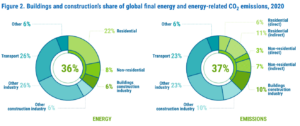Carbon Emissions in Construction – 3 Key Pillars: Methods, Materials, And Tech Transform
Data from the United Nations Environment Program indicate that building and construction contribute nearly 39% of the world’s carbon emissions.
In 2021, the sector put out 10 gigatons of carbon emissions. That was 5% higher than 2020 levels and 2% more than the pre-pandemic peak reached in 2019.
The Paris Agreement set the targets to reduce energy intensity for buildings by 30% per square meter by 2030 and to have the entire construction industry at net zero by 2050.
The industry is considerably off-track when it comes to achieving these climate goals. If the industry doesn’t invest in critical changes now, emissions are predicted to double by 2050. Many in the industry are evolving into new practices, though.
53% of construction industry executives say they expect the sustainability trend to accelerate in the coming years, and 10% say they are invested in sustainability solutions since the pandemic.
Carbon Emissions in Construction – Greener construction methods
Greener construction methods such as prefabrication, modularisation, and digitalisation (building information modelling, for example) are paving the way for this change.
Instead of building structures on-site from scratch, these approaches enable elements to be manufactured separately off-site and combined with customisation options once they arrive at the building site, resulting in as much as 30% lower carbon footprints. Modular construction reduces the amount of wasted materials and results in a safer construction site. The buildings also take up to 50% less time to build.
Although modular construction accounts for only 4% of residential construction and 5.5% of commercial builds in the US, it’s utilised in 45% of projects in Sweden and 15% of projects in Japan. Modular construction is becoming especially popular in the healthcare sector where demand for space has reached an all-time high.
This type of construction is a logical fit for hospitals, which need to build several of the same patient rooms in succession. It also requires fewer construction personnel to be on-site, which lowers safety and infection concerns for patients. Beyond new construction methods, industry leaders are also coming up with new materials aimed at creating a more sustainable future.
Carbon Emissions in Construction – Newer Lower-Footprint Materials
Newer, lower-footprint materials, such as cross-laminated timber in place of steel, ethylene tetrafluoroethylene (ETFE) in place of glass, mycelium (a type of fungus spore) instead of bricks, and advanced materials such as graphene to reduce concrete usage, all promise to lower the environmental impact and change how structures are built.
The use of ETFE is beneficial for the environment in several ways. The material is resistant to damage caused by UV light, pollution, and overall weathering, so its life expectancy is 50+ years. It’s lightweight, so it’s easy to transport and needs a less extensive framework to support it.
The material has become the first choice for the roofing in sports stadiums. US Bank Stadium in Minneapolis was the first to use ETFE in 2016, but since then many others have followed suit. SoFi Stadium in Inglewood, California, recently built the largest ETFE roof to date — 67,000 tons of ETFE membrane covering more than 3 million square feet.
How Antaris can help evaluate Carbon Emissions in Construction
Antaris specalises in energy and carbon management. We have worked with several construction companies to support their transition to a low carbon and low energy business model. We support our construction clients with emission reduction targets, decarbonisation plans, setting Science-Based Targets and implementing energy management systems and conducting energy audits.
Find out more by visiting our website: Leading Sustainability & ISO Consultants – Antaris Consulting
Sources
2021 Global Status Report for Buildings and Construction | UNEP – UN Environment Programme



